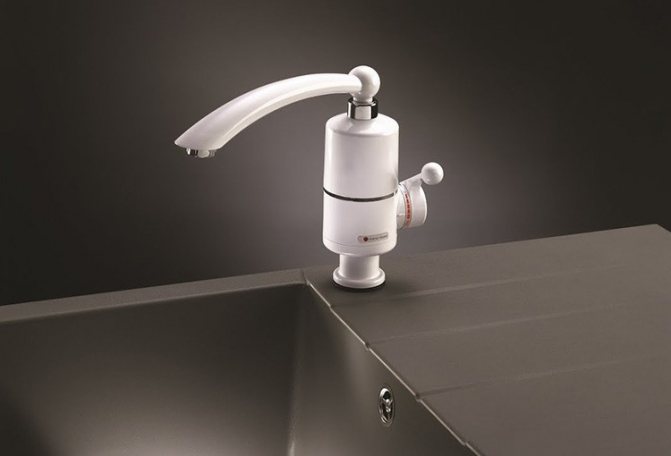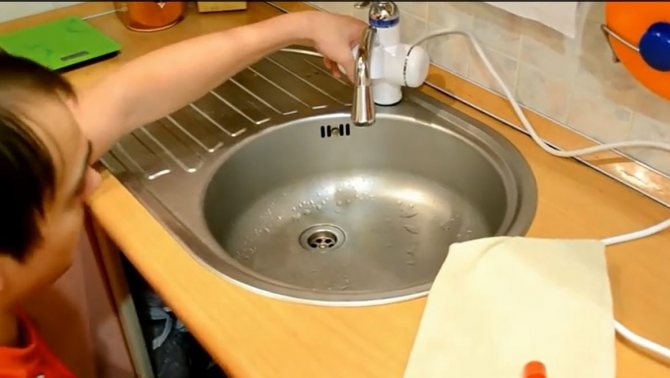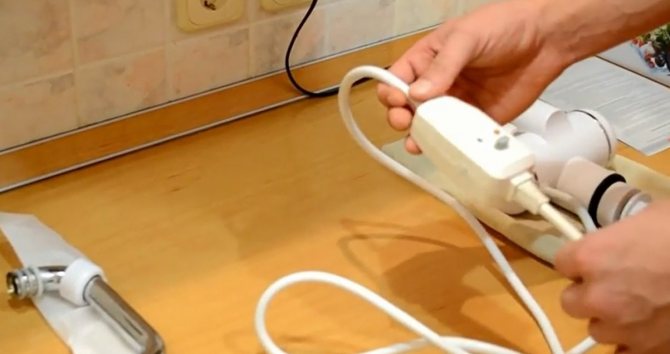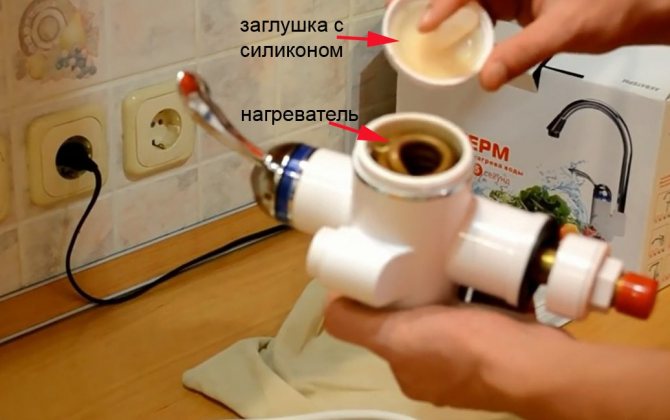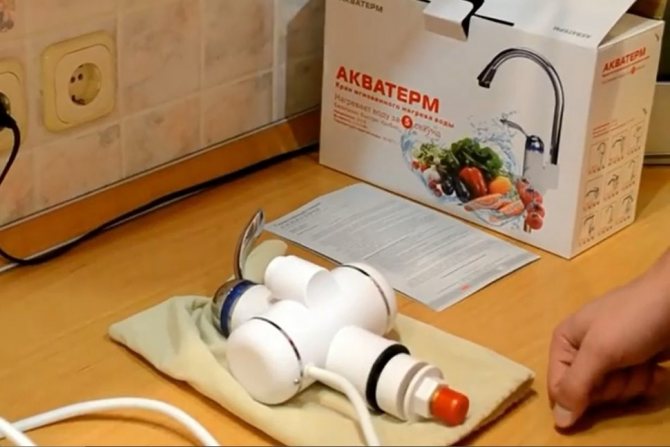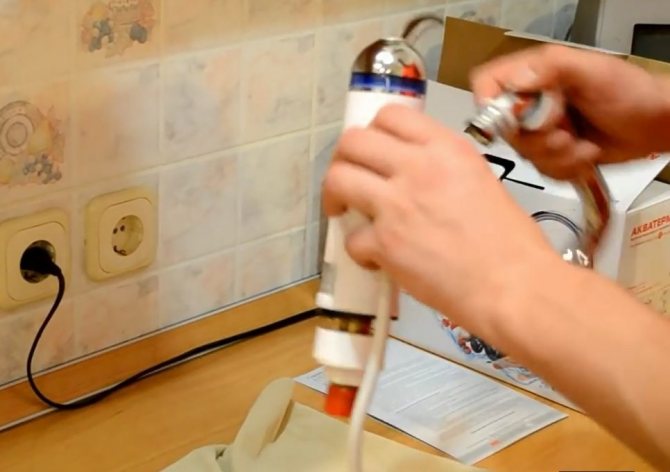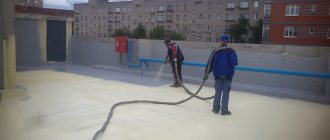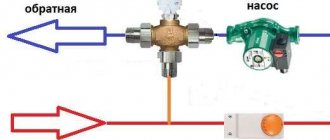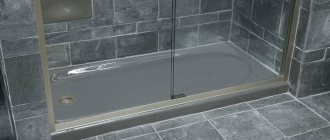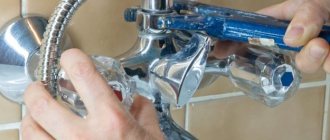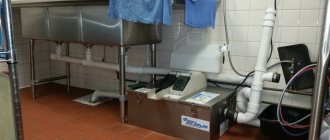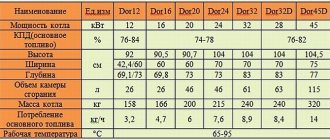With frequent shutdowns of hot water, the homeowner thinks about buying a flowing electric water heater for a tap. Such a device is easy to use and install, compact in size. When choosing a device, technical characteristics are taken into account, which must correspond to the operating conditions and the needs of the residents.
A flowing water heater is a small device that heats the water flowing through it.
The device and design of the electric heater on the tap
The heating nozzle on the tap looks like a simple mixer. A distinctive feature is its large size. In the protective case there are heating elements and elements that are responsible for the safety of using the device. More expensive models are equipped with a digital display, temperature sensors.
Inside the module there is a cartridge that regulates the liquid flow rate and a container with a powerful heating element. The presence of this part explains the high speed at which the required temperature is reached.
The compact tap water heater is equipped with a security system that includes the following elements:
- Water flow power sensor. Turns off the heating element in the event of a critical drop or increase in pressure. Strong pressure damages system parts.
- Water presence and temperature sensors. They prevent the heating element from burning out when the liquid supply is stopped. The flow sensor provides quick warm-up when the tap is opened.
- Fuse. If the characteristics of the electric current change or a short circuit occurs, the device is automatically disconnected from the network.
- Silicone damper. Protects the device from water hammer.
What does a water heater tap consist of?
The design of the instant water heating tap includes:
- pouring out
through which heated water is supplied; - body
with a small reservoir and heating element. Cold water is supplied here for heating; - sensors and filters
... The former show the temperature of the water, the latter cleanse from harmful impurities; - power cord with RCD
as well as fasteners.
Despite the apparent complexity of the design, the installation of a water heater tap is not much different from the usual mixers. Read more about installation in this article.
Varieties of compact equipment
Flow-through water heating means are divided into the following categories:
- Separate heating nozzle. The device is put on the spout of the previously installed tap. There is no need to perform complex installation work. The disadvantages of the nozzle are low power, weakness of pressure. The device heats up no more than 4 liters of liquid per minute. Compact dimensions do not allow completing heaters with complex safety modules. There is only a thermal sensor that does not allow the combustion of the heating component.
- Heating mixer. Heated taps are becoming more and more popular. The device operates in several modes. Turn the knob to the right to select hot water dispensing. The heating module is activated providing the user with warm liquid. Turning the knob to the left will shut off the electrical system. Cold water flows from the spout. When the regulator is set to the middle position, the device is de-energized, the fluid supply is stopped.
- Wall-mounted flow heater. Such models can serve several plumbing fixtures at the same time. It is reliably protected from overheating, voltage drops. Performance exceeds that of the previous two types.The equipment, which looks like a small box, is mounted on the wall. The oversized heating element allows the fluid temperature to rise rapidly. Wall-mounted devices are either pressure or non-pressure.
All types of instantaneous water heaters in Tyumen can be viewed in the KVANTA + online store.
Popular models
On our market there are faucets-heaters for water of Russian, Chinese, European production. Firms offer models for all segments of the population. Regardless of the cost, all types do a good job - they quickly and safely heat running water.
The most popular models of heated taps:
- Delimano;
- Sapretto;
- Aquatherm.
These are affordable and reliable devices on the Russian market.
Delimano

Instant heating cranes of the Italian-Ukrainian company are made in China. The power cord is plugged in at the back, the water temperature is regulated by the side knob. Blue and red marks show the operating mode. Lever swivels left and right, can be used for 2 sinks. Both hydraulic and electronic versions of the flow heater are available.
The compact vertical housing takes up little space, can be used as a back-up heater, suitable for summer cottages, new buildings, as long as the central hot water supply system is not connected. The manufacturer offers various modifications designed for small and large volumes of water consumption.
Wall mounted water heater with display is equipped with a hose, shower, powerful heating element. In such samples, a reinforced heater, a more powerful system of protection against overheating, "dry" operation, water hammer. Flow models are equipped with electronics, the operating parameters are displayed on the screen.
Supretto


The stylish heater is produced in Hong Kong. The vertical body is in the shape of a cylinder, white with a silver finish. Temperature control is done with a side lever. The electrical cord is connected at the bottom. Suitable for small amounts of hot water. Models are not equipped with a shower, they are installed on a countertop or on a sink. Dense plastic protects the body from water hammer, the rate of passage of cold water - 1.5 l / min, heated to 50 ° C - 1.3 l / min. works from a standard network of 220-240 V, the length of the wire is 1 m, so it is necessary to think over the connection to the outlet.
Supretto produces the same models as Delimano, but under their own brand. Like Delimano, there are more expensive models with a display.
Aquatherm
An overview of popular models is impossible without a representative of domestic production.
The flow-through device of the Russian company has a horizontal or vertical body. The buyer can also choose the color of the heater. The manufacturer offers samples with a long and short drain, a hose with a shower head, electronic temperature control. Medium-power equipment heats water up to 60 ° C, operates from a 220 V network. The price of a crane depends on the model - the consumer can choose a sample that is suitable in terms of power and design. This is a good combination of affordable price and high quality.
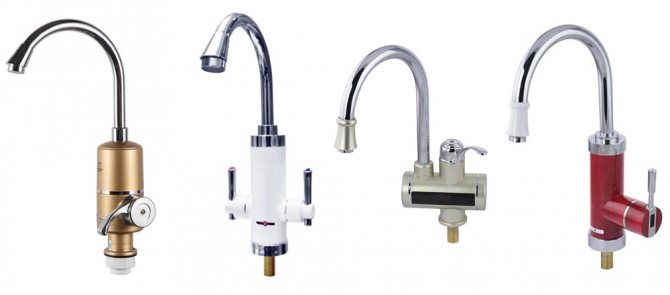

Features of the flow heater
When installing heating equipment, the following nuances are taken into account:
- Limiting the amount of heated liquid. The flow rate rarely exceeds 6 l / min. The performance of the gas heater is 2 times this value.
- Increased load on the electrical network. Installing the attachment in old houses requires a separate wire to be laid. It is mandatory to connect through a grounded outlet equipped with an RCD.
- Possibility of servicing a single water intake point. The supplied volume of heated liquid is not divided into several streams. To provide hot water to the whole house, a boiler or wall-mounted flow heater is purchased.
- Complexity of service.In the event of a malfunction, it is difficult to repair the portable device. Repair kits are rarely produced by manufacturers.


The main advantage of such hot water installations is their compactness.
Installation Recommendations
Despite a number of limitations that we have cited above, the scope of application of flow-through heating nozzles on a tap is very extensive.
So, the most justified setting would be:
- In apartments and private houses with unstable hot water supply. If your hot water is turned off at an incomprehensible frequency, then you will have to either spend money on the purchase of such a device, or wash yourself with cold water.
Note! If the shutdowns last more than a month, then instead of such a system, it is better to install a full-fledged boiler: its efficiency will be much higher, and it is more convenient to use it.
- In summer cottages and country cottages, i.e. where hot water supply is needed in limited volumes.
- The kitchens of the houses have autonomous gas heating. In order not to start the boiler for the sake of washing several dishes, it is quite possible to use such a compact device - it will turn out faster, more convenient, and cheaper.


For a country kitchen or a washstand, such models are perfect.
Feasibility of use
To understand whether it is worth installing a compact water heater in your own apartment, they evaluate the advantages and disadvantages of the device.
The positive qualities of the equipment in question include:
- Compact dimensions. This advantage becomes the main one for the owner of a typical apartment. The heater takes the place of a standard mixer on a sink or wall.
- Increased warm-up speed. Regardless of the power of the appliance, hot water starts to flow in 10-30 seconds. Standard boilers are turned on 20-30 minutes before the start of use.
- Maintaining a constant temperature. Modern models are equipped with sensors that regulate the heating of the heating element.
- Aesthetic qualities. The variety of models allows you to choose a device that matches the design of your kitchen or bathroom.
- Easy to install. The installation process does not differ from that of a simple mixer. Additionally, an electric cable is supplied.
- Increased efficiency. The device works only when in use. After closing the tap, energy is no longer consumed.
Manufacturers of instantaneous water heaters claim to be economical. However, this is not quite true. The power of the heating element reaches 4.5 kW. With frequent use of the device, energy costs increase.
Taps with an electric heater - which is the best fit
Instant water heating taps are the cheapest devices capable of heating water and supplying it to the spout, moreover, comfortably, without any unnecessary actions on the part of the consumer. Here, at least rubles spent on equipment in terms of a liter of finished water. In this case, you just need to open the tap and after a couple of seconds, while the device itself heats up, hot water will flow.
But even these heaters differ significantly in terms of characteristics and price. What to choose, which fast water heating tap is the best fit.
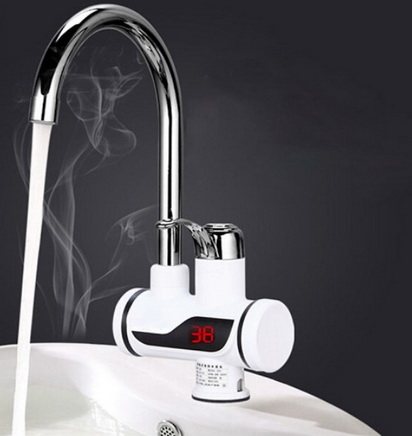

Typical design
In the heating tap, the heating element is located in the mixer body. Usually the following can be distinguished in the design:
- cold water connection,
- ceramic cartridge for cold and hot water mixer,
- housing with spout and cartridge control handle and switch,
- spiral ten-heater, but in powerful 380 V devices it is possible to use several ten.
- electric tena switch paired with a control handle.
This is an elementary on-off mechanical control.
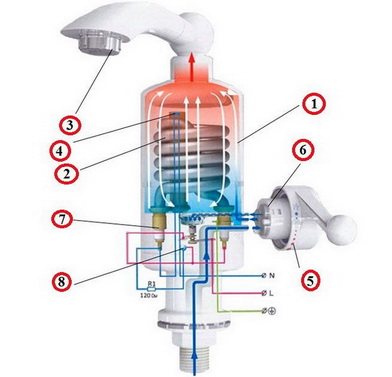

But for powerful 380V models, it is also possible to adjust the heating power, usually stepwise, according to the number of tens simultaneously included in the work.This means that the temperature of the water is also regulated at the same flow rate.
More expensive models can also be equipped with an electronic display indicating the water temperature and sensors for turning on tendencies, depending on the actual water consumption.
Instant water heating taps can be designed to work with a 220 V or 380 V network. The power of the first is in the range of 2.5 - 6.0 kW, and the power of the second three-phase can reach 25 kW.
What is the temperature of the water from the heating tap, is it sufficient to set the bath
Faucet manufacturers indicate an abstract heating temperature of +60 degrees and 80 degrees, without notifying either the initial temperature or the amount of heated water per unit of time. The main characteristic of flow-through heaters remains heating performance - the number of liters of water heated by 25 degrees. For example, at the inlet temperature is 8 degrees, at the outlet - 33 degrees, with a flow rate of 3 liters per minute. But you can get a higher temperature, for example, hot 40 - 50 degrees, simply by reducing the flow rate by one third or half ...
In fact, the popular 3 kW cheap water heater taps provide only a thin warm stream, a small shower for washing dishes. It is impossible to take a hot bath with the help of them, the water will simply cool down during the set.
To set a bath, you need at least a 15-kW flow heater with a three-phase power supply, but preferably even more powerful ...


Next, let's compare the advantages of a heating tap and a storage boiler.
A faucet with water heating has the following advantages
- The minimum price of equipment and the minimum dimensions are just an ordinary mixer with a slightly larger body, inside which there is a heating element.
- Extreme simplicity of installation, which does not require alteration of the system, - it is enough to dismantle the mixer on the sink and install a faucet-heater in its place, and also connect it to the mains, for 3 kilowatt ones, just plug the plug into the outlet.
- Better energy savings compared to a boiler. Almost all the energy from electricity will be used to heat water, which is immediately supplied to the consumer. With a boiler, when it cools down, 30% of the energy can be consumed (spent on heating the dwelling) from each heating.
- Hot water is generated immediately at will, and its quantity is conventionally infinite - as long as there is a supply of cold and energy. The boiler runs out of warm water, its not so powerful ten cannot be heated on the go. To get the first heating with a boiler, you need to wait a long time, usually at least an hour.


The advantages of the boiler are significant
- The boiler can provide hot water conditionally "like an avalanche" - a lot of hot or very hot water at once, if necessary. To fill a hot bath with a 100-liter boiler heated to 80 degrees - no problem. Rinse something with a high pressure of hot water - please. Such comfort in terms of consumption is barely achieved with a 25-kilowatt pipe.
- The boiler has a stable heated water temperature. It is difficult with cheap flow pipes in this regard - the temperature jumps after the change in flow rate, fluctuations in the pressure in the network. But for the tap in the sink and sink, this is not so critical.
- A boiler with a tenth of 1.5 - 2.2 kW is connected to any network. And the protochnik - only to high-quality 220 V, and more powerful than 3 kW - a special connection.
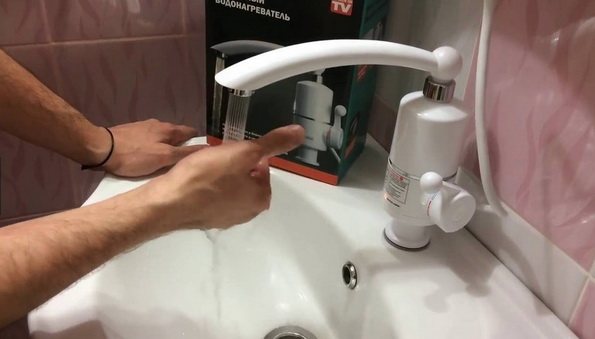

What is usually chosen
It is very convenient to install a 3-kilowatt cheap faucet-heater on the kitchen sink and use it to obtain water of acceptable temperature for rinsing the plates. The same is true for the bathroom sink for washing hands, but together they can only work in a 32-amp 220 V network.
A faucet with a shower tap is not bad in the bathroom, provided that its power is over 20 kW.


Correct connection of the flow valve
It remains to be remembered that the 3-kilowatt flow heater in the tap loads the old electrical wiring with a 16-amp automatic shutdown, as they say, in full.In addition to it, only very insignificant consumers can work. But you can connect it to a grounded outlet in a common kitchen (powerful) network.
It is advisable to connect models 4-6 kW 220 V with a separate wire from the switchboard with appropriate protections (32 A). Three-phase heaters are also special connection only.
The flow-through faucet-heater is installed on the sink with one washer, and its only hose is connected to the cold water supply.
Criteria for choosing a water heater
Before purchasing the equipment, the required power is calculated, the technical characteristics of several models are compared.


Electric heaters allow heating the liquid almost instantly.
Performance and power
When choosing a water heater, take into account the installation location - bathroom, kitchen. The estimated capacity of the equipment depends on this.
To calculate the indicator, use the formula: W = V * (T2-T1) /14.3, where:
- W is the required power of the device, kW;
- V is the volume of consumed water;
- T2 is the required heating temperature (depends on the purpose of using the equipment);
- 14.3 - constant value;
- T1 is the temperature of the liquid present in the water supply system (+15 ° С - in summer, +5 ° С - in winter).
Heating element type
TEN is the main component of the device.
Most often it has a spiral shape that increases the contact area. Curved or straight heating elements are less common.
The efficiency and service life of a part depends on the material of manufacture:
- Heating element with copper coating. Differs in good thermal conductivity, resistance to scale formation.
- Tubular ceramic heater. Provides the device with high performance. Differs in high cost.
- Glass-covered spirals. Parts are undemanding to maintain, however, when scale appears, their thermal conductivity decreases.
Operational safety
In addition to the standard protective equipment, the conformity of the housing to the standards is assessed.
When choosing a heater, 2 parameters are taken into account:
- the degree of protection against shock to the user;
- moisture protection class.
Most instantaneous water heaters have 1 degree of protection. This means that conductive components must be insulated and grounded.
Other parameters
In addition to standard indicators, when purchasing equipment, the following characteristics are taken into account:
- body material;
- control method;
- availability of additional functions.
Flow heaters are mechanical and electronic. The former have 3 operating modes, manually switchable. Electronic devices independently maintain the required indicators. The attachments are constantly exposed to negative factors, so the body must be made of high-quality materials - polypropylene, stainless steel, copper.


